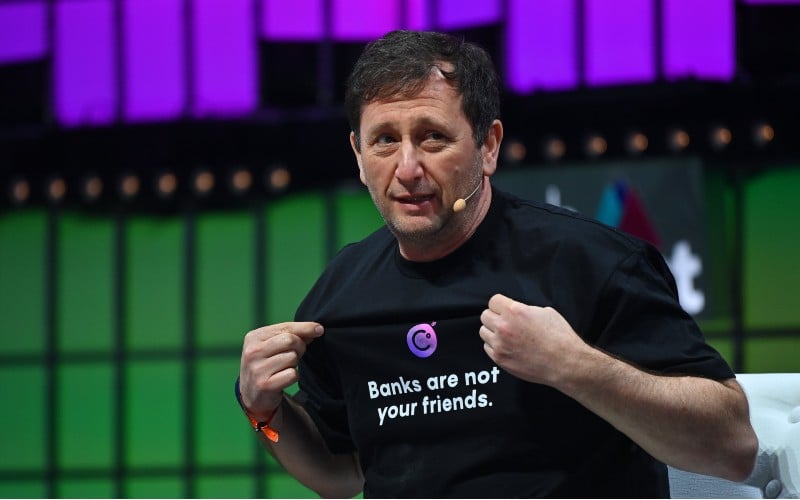Cryptocurrency lender Celsius Networks has filed for Chapter 11 bankruptcy.
The company’s products allowed people to earn interest when depositing their cryptocurrencies with it. It also lent out cryptocurrencies.
However, it paused withdrawals and transfers between accounts last month, blaming ‘extreme market conditions’ triggered by the collapse of the Terra ecosystem.
Securities regulators in New Jersey, Texas and Washington were investigating the company, led by CEO Alex Mashinsky (pictured at Web Summit last year), over this decision.
“Today’s filing follows the difficult but necessary decision by Celsius last month to pause withdrawals, swaps, and transfers on its platform to stabilise its business and protect its customers,” the company stated.
“Without a pause, the acceleration of withdrawals would have allowed certain customers – those who were first to act – to be paid in full while leaving others behind to wait for Celsius to harvest value from illiquid or longer-term asset deployment activities before they receive a recovery.”
Listing its estimated assets and liabilities at between $1 billion and $10bn, it said it had $167m cash to provide liquidity during the restructuring process.
However, it is not requesting authority to allow customer withdrawals.
Celsius raised $750 million in Series B funding last year from investors including WestCap and Caisse de dépôt et placement du Québec – Canada’s second-largest pension fund – valuing the company at several billion dollars.
It also raised $20m in crowdfunding in 2020.
Crypto exchange FTX, which is looking at bailing out several struggling crypto companies, reportedly passed on the opportunity to buy the struggling lender due to the state of its finances.
Would you burn a Damien Hirst artwork? NFT experiment nears end
Renowned artist Damien Hirst’s NFT experiment comes to a close in two weeks.
Hirst created 10,000 pieces of art – you can see the details and process behind these ‘messy dots’ works in the video below – featuring unique handwritten titles which are currently stored in a secure vault.
Those who bought them – at $2,000 apiece – were sent the corresponding NFT, stored on the Palm blockchain. They were given a year – until July 27th 2022 – to decide whether to keep the physical or digital version. Those who burned their NFT will receive the physical artwork after that date, while the others will be destroyed.
There are 7,889 NFTs remaining, with 2,111 burned to date. The cheapest NFT in the collection currently costs almost $9,000.
Hirst says the experiment is about how we perceive value in money and art.
Cryptocurrency shorts
Ethereum scaling tool Polygon has been selected with five other companies for Disney’s 2022 Accelerator. The business programme, which begins this week, is looking to develop new technologies within augmented reality, non-fungible tokens and artificial intelligence.
UK law firm Giambrone & Partners has served a lawsuit via NFTs for the first time. The case, brought by Fabrizio D’Aloia against Binance Holdings, Poloniex, gate.io, OKX and Bitkub over allegations that someone was operating a fraudulent clone online brokerage, saw parties served by airdropping NFTs into wallets originally held by D’Aloia but stolen by unnamed individuals.
Tesla has lost $440 million on its Bitcoin stock, according to analysis from StockApps. Other companies hit hard by the crypto winter include MicroStrategy – which lost more than $1 billion – Block, Square and Marathon Digital Holdings.
eukhost – a fully managed WordPress hosting provider for bloggers
Crypto prices
The overall market cap of the more than 20,200 coins is at $896.1 billion at the time of writing (7am UK), a 2.8% increase in the last 24 hours.
Market leader Bitcoin – the original cryptocurrency created by the mysterious Satoshi Nakamoto – gained 3% to $20,100. BTC is 1% down in a week.
Ethereum, the second most valuable crypto coin – created as a decentralised network for smart contracts on the blockchain – rose 5% to $1,105. ETH is 5% down over the course of a week.
Binance Coin is a cryptocurrency created by popular crypto exchange Binance to assist its aim in becoming the infrastructure services provider for the entire blockchain ecosystem. Its BNB token added 3% to $231, leaving it 2% down over seven days.
The XRP token of Ripple, a payment settlement asset exchange and remittance system, acts as a bridge for transfers between other currencies. XRP gained 2% to 32.2 cents, with its price 2% down on seven days ago.
Cardano is an open source network facilitating dApps which considers itself to be an updated version of Ethereum. Its ADA token, designed to allow owners to participate in the operation of the network, rose 2% to 43c and is 7% down in a week.
Solana is a blockchain built to make decentralised finance accessible on a larger scale – and capable of processing 50,000 transactions per second. Its SOL token rose 4% to $34.40 and is 6% lower than its price a week ago.
Meme coin DOGE was created as a satire on the hype surrounding cryptocurrencies but is now a major player in the space. DOGE remained below 6.1c, leaving it 11% down in a week.
Polkadot was founded by the Swiss-based Web3 Foundation as an open-source project to develop a decentralised web. Its DOT token, which aims to securely connect blockchains, grew 1% to $6.48 and is 6% down on its price a week ago.
Avalanche is a lightning-quick verifiable platform for institutions, enterprises and governments. Its AVAX token rose 8% to $18.56 and is 3% down in a week.
To see how the valuations of the main coins have changed in recent times – and for round-ups of recent cryptocurrency news developments – click here.
For valuations of the top 100 coins by market cap in US dollars, plus 24-hour price change, see below.


